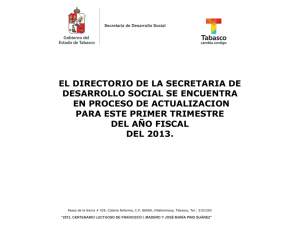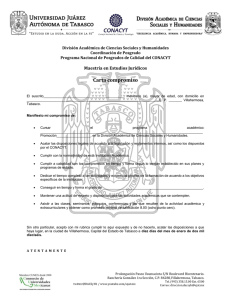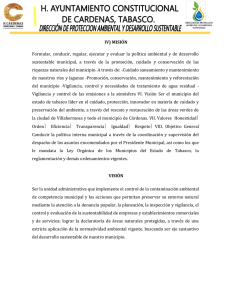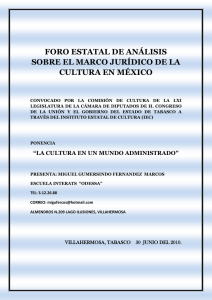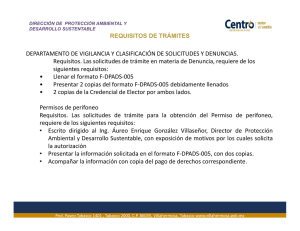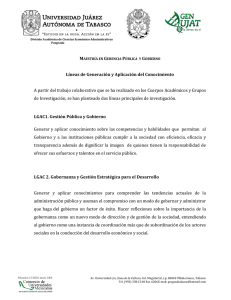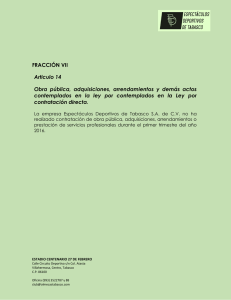DISEÑO DE UN HOSPITAL DE ESPECIALIDADES
Anuncio
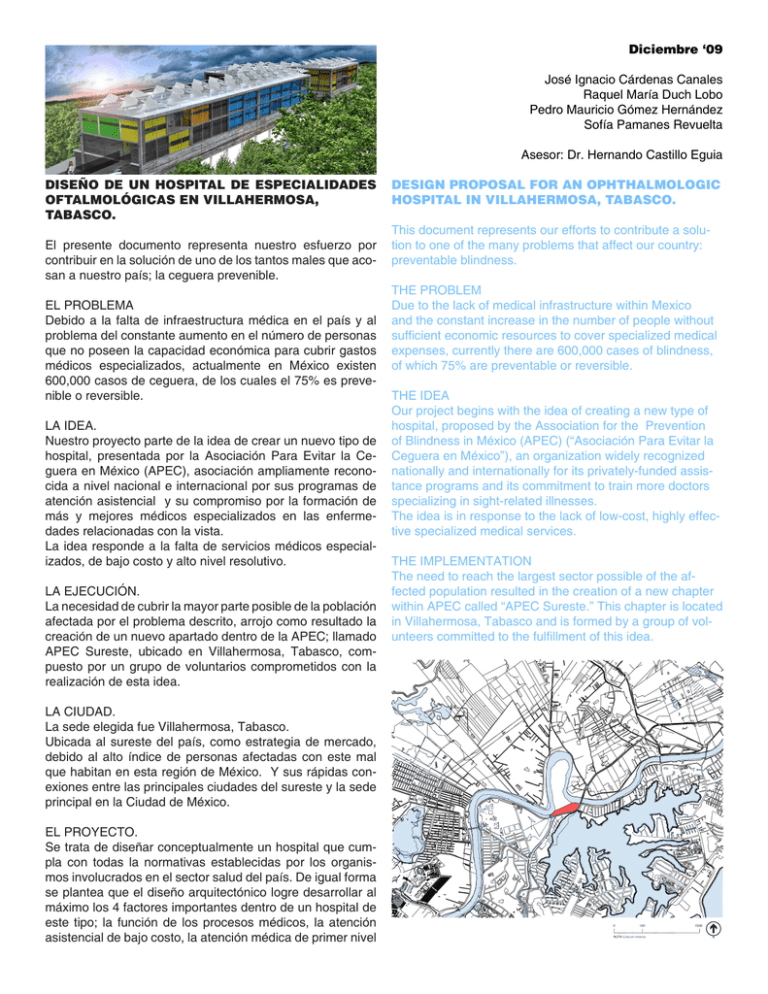
Diciembre ‘09 José Ignacio Cárdenas Canales Raquel María Duch Lobo Pedro Mauricio Gómez Hernández Sofía Pamanes Revuelta Asesor: Dr. Hernando Castillo Eguia DISEÑO DE UN HOSPITAL DE ESPECIALIDADES OFTALMOLÓGICAS EN VILLAHERMOSA, TABASCO. El presente documento representa nuestro esfuerzo por contribuir en la solución de uno de los tantos males que acosan a nuestro país; la ceguera prevenible. EL PROBLEMA Debido a la falta de infraestructura médica en el país y al problema del constante aumento en el número de personas que no poseen la capacidad económica para cubrir gastos médicos especializados, actualmente en México existen 600,000 casos de ceguera, de los cuales el 75% es prevenible o reversible. LA IDEA. Nuestro proyecto parte de la idea de crear un nuevo tipo de hospital, presentada por la Asociación Para Evitar la Ceguera en México (APEC), asociación ampliamente reconocida a nivel nacional e internacional por sus programas de atención asistencial y su compromiso por la formación de más y mejores médicos especializados en las enfermedades relacionadas con la vista. La idea responde a la falta de servicios médicos especializados, de bajo costo y alto nivel resolutivo. LA EJECUCIÓN. La necesidad de cubrir la mayor parte posible de la población afectada por el problema descrito, arrojo como resultado la creación de un nuevo apartado dentro de la APEC; llamado APEC Sureste, ubicado en Villahermosa, Tabasco, compuesto por un grupo de voluntarios comprometidos con la realización de esta idea. LA CIUDAD. La sede elegida fue Villahermosa, Tabasco. Ubicada al sureste del país, como estrategia de mercado, debido al alto índice de personas afectadas con este mal que habitan en esta región de México. Y sus rápidas conexiones entre las principales ciudades del sureste y la sede principal en la Ciudad de México. EL PROYECTO. Se trata de diseñar conceptualmente un hospital que cumpla con todas la normativas establecidas por los organismos involucrados en el sector salud del país. De igual forma se plantea que el diseño arquitectónico logre desarrollar al máximo los 4 factores importantes dentro de un hospital de este tipo; la función de los procesos médicos, la atención asistencial de bajo costo, la atención médica de primer nivel DESIGN PROPOSAL FOR AN OPHTHALMOLOGIC HOSPITAL IN VILLAHERMOSA, TABASCO. This document represents our efforts to contribute a solution to one of the many problems that affect our country: preventable blindness. THE PROBLEM Due to the lack of medical infrastructure within Mexico and the constant increase in the number of people without sufficient economic resources to cover specialized medical expenses, currently there are 600,000 cases of blindness, of which 75% are preventable or reversible. THE IDEA Our project begins with the idea of creating a new type of hospital, proposed by the Association for the Prevention of Blindness in México (APEC) (“Asociación Para Evitar la Ceguera en México”), an organization widely recognized nationally and internationally for its privately-funded assistance programs and its commitment to train more doctors specializing in sight-related illnesses. The idea is in response to the lack of low-cost, highly effective specialized medical services. THE IMPLEMENTATION The need to reach the largest sector possible of the affected population resulted in the creation of a new chapter within APEC called “APEC Sureste.” This chapter is located in Villahermosa, Tabasco and is formed by a group of volunteers committed to the fulfillment of this idea. THE CITY The proposed location for the hospital is Villahermosa, Tabasco. This city was selected for several reasons. First, it is located in the southeastern region of Mexico, a region where a large percentage of the affected population resides. In addition, it is strategically located, being well-connected to all the major cities in the region including Mexico City. y la factibilidad económica. EL PROGRAMA. Un hospital de 6000 mts2, que mezclará cinco tipos de usuarios diferentes (médicos, administrativos, paciente asistencial, paciente privado y trabajadores generales), y no generará interrupciones entre los procesos de cada uno. LA INTENCIÓN. Un eje rector que coordina las necesidades cualitativas del programa arquitectónico con las del contexto donde se ubicará el proyecto, dando como resultado un gran pasillo que atraviesa por completo el edificio y que ubica los diversos tipos del programa según el proceso más importante que es el del paciente en general. La parte de humanizar el hospital se dio mediante la inserción de jardines interiores que rompen con la monotonía del pasillo y avisan del cambio de programa que está por suceder. Los interiores así como los exteriores son el reflejo plástico de la lectura del programa arquitectónico, con el fin de crear un mapa visual y así agilizar los procesos dentro del hospital. LA CONCLUSIÓN. La función y la plástica como respuesta encontrada en la mezcla de un programa arquitectónico complejo, con conceptos de diseño que a simple vista parecieran sencillos. Plan Maestro Master Plan THE PROJECT The project reflects an attempt to design a hospital conceptually that meets all the requirements set forth by the regulatory agencies in the Mexican Health Sector. In addition, the architectural design attempted to optimize the four factors important for this type of hospital: 1) functionality of the associated medical procedures, 2) low overhead costs, 3) low-cost medical services, and 4) state-of-the-art medical attention. THE PROGRAM The project consists of a 6,000 square meter hospital that serves five different types of individuals (i.e., doctors, administrative personnel, patients with the means of paying for medical treatments, low-income patients, and general workers) and meets the needs of each of these individuals. THE INTENTION The design will provide an underlying, governing framework that will link the qualitative needs of the architectural program with the conceptual context of the project. This design features a large hallway that completely transects the building and connects different sections of the hospitalaccording to priority, the most important being patient care. To create a human element within the hospital, indoor gardens were designed to eliminate the monotony of corridors and to serve as visual indicators of respective programs. The interiors as well as the exteriors are an adaptive reflection of the architectural program, for the purpose of creating a visual map and thereby facilitating hospital operationsl. THE CONCLUSION Both the function and form of the hospital provide a solution to a combined architectural challenge with design concepts that at first appear simple.
